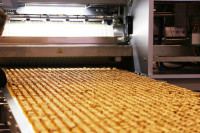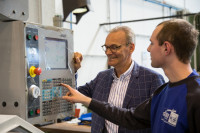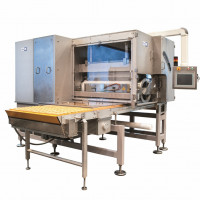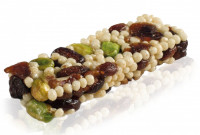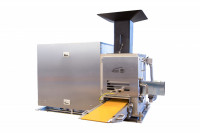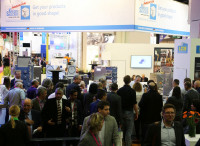Krüger & Salecker Maschinenbau GmbH & Co. KG
sp portrait: Machines for healthy snacks
Krüger & Salecker Maschinenbau GmbH & Co. KG is celebrating its 70-year anniversary this year. The company is one of the leading manufacturers of forming machines for the confectionery industry. What makes them special: they don’t destroy the ingredients in products like granola bars or balls.
Our company’s secret? The power of innovation and a knack for global trends,” replies Jörg Maskow, owner of the machine manufacturing company Krüger & Salecker (K&S), based in Bad Schwartau/Germany. The company was founded 70 years ago, and Jörg Maskow has been the sole proprietor since 2003. The 55-year-old can’t help but smile during a stroll through the production hall. He is visibly proud of what he and his employees have achieved. He‘s already looking forward to the jubilee celebrations in June. “We are one of the leading manufacturers of forming machines for the confectionery industry,” explains the company boss. “We are especially adept at processing natural foods and cereal products, such as granola bars and balls.”
Dressed in jeans and a blazer, the man in his mid-fifties strolls through the plant, greeting his “team”, as he calls them, and talks with a few of his employees. “Here, we’re currently completing a GFW equipment system for cereal processing,” he says pointing to a 3.5 t heavy and almost 3 m tall colossus made of stainless steel. Early on, Krüger & Salecker saw the trend towards healthy foods like nutritious snacks based on grains, nuts and dried fruits without added sugar – these are the absolute trends in the food industry. It’s in keeping with the motto “healthy and delicious, not fried and fatty.” The company jumped on board early with the healthy food trend and in recent years has provided large, global clients with equipment to produce healthy foods. “The demand for these processing machines is increasing,” knows Jörg Maskow, who finds the healthy turn in the confectionery industry a good thing from more than just a business perspective. “It’s time that this industry shows what it’s capable of. First and foremost, it can’t be loaded with calories, processed and unhealthy. The end consumers’ lifestyle has changed, and the industry is finally reacting to it.”
Early recognition of the healthy food trend
The key feature of the North German forming machines is that they don‘t destroy or otherwise crush the ingredients of the granola bars. “With our competitors, the granola mass comes out of the machine in the shape of a large carpet which is then cut into bar forms with blades, like with a circular saw,” explains Maskow. “Yet, this destroys the ingredients. Nuts, for example, lose their oil as a result, and the bar gets mushy at these locations.”
The bars produced by the Krüger & Salecker machines are formed individually. Nothing is cut or crushed. The bars achieve their shape through section rolling. In this manner, the granola mass is gently poured in, and the finished bars land individually on the conveyor belt. “Thanks to our special process, food makers need less binding agent which cuts down on calories,” shares Jörg Maskow. “Cereal products made in this fashion require just a fraction of the binding agent amount necessary for conventionally produced bars.”
Like many internationally successful companies, Krüger & Salecker started as a small operation. In the beginning, the company was not active in the food industry. The company’s history begins with a cellar workshop in Lübeck on 1 July 1948. Robert Krüger und Heinrich Salecker manufactured desperately-needed pots, pans and cutlery in the early post-war years in Germany. After a short time, the young company built its first machines for the food industry.
In keeping with Lübeck’s history of marzipan making, the first machine they made was one that could form marzipan. “One of these initial machines is still running today,” assures Jörg Maskow. It’s no longer in constant operation but still works today as it did when it was delivered in 1955.
In the early 1990s, Paul Asmuth took control of the company. He expanded the programme at Krüger & Salecker to include machines that make grinding discs and disc brake pads. During this time, confectionery ebbed into the background. In 1998, the machine programme from the fellow Lübeck-based company Ketter was acquired and integrated into the confectionery machine segment. In 2001, an in-house company technical centre was established where test runs could be conducted, amongst other things.
After Jörg Maskow took control, Krüger & Salecker underwent yet another transformation. “Our machines use a modular concept, so that we can shape practically anything from soft to semi-soft masses,” emphasises Maskow. “Our clients include the small pastry chef next door as well as the world’s largest food companies.”
Success in more than 25 countries worldwide
In late 2008, K&S moved into new premises on the “green meadow” of Bad Schwartau where multiple machines could be built simultaneously. Besides cereal formers, the product line-up includes various forming, rolling, and streusel machines as well as extruders. The number of employees increased from ten in 2003 to almost 60 today. As a global player, the company now has a number of representatives in more than 25 countries – from Europe to America and beyond to India, Japan and Australia.
“We are where we are today because of my team’s drive,” reflects the company boss. However, that‘s not enough for him and his team: “We are driven by innovation, the constant pursuit of being better and faster than our competitors. That‘s what defines Krüger & Salecker.” •

